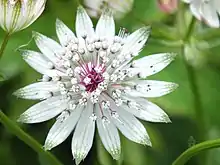Astrantia major
Astrantia major, the great masterwort, is a species of flowering plant in the family Apiaceae, native to central and eastern Europe. Growing up to 90 cm (35 in) tall by 45 cm (18 in) broad, it is an herbaceous perennial, much used in gardens.
| Astrantia major | |
|---|---|
 | |
| Scientific classification | |
| Kingdom: | Plantae |
| Clade: | Tracheophytes |
| Clade: | Angiosperms |
| Clade: | Eudicots |
| Clade: | Asterids |
| Order: | Apiales |
| Family: | Apiaceae |
| Genus: | Astrantia |
| Species: | A. major |
| Binomial name | |
| Astrantia major | |
| Synonyms[1] | |
| |

Etymology
The Latin specific epithet major, meaning "larger", distinguishes this species from its smaller relative Astrantia minor.[2]
Description
Astrantia major reaches on average 60 centimetres (24 in) of height. The stem is erect and glabrous, with little branches and few leaves. The basal leaves have a long petiole 10–20 centimetres (3.9–7.9 in), 3 to 7 lobes and toothed segments. Size: 8–15 centimetres (3.1–5.9 in). The cauline leaves are generally two, sessile, amplexicaul and lanceolate-shaped with a trilobed apex. The inflorescence is umbrella-shaped, with 2–3 centimetres (0.79–1.18 in) of diameter. The floral bracts are numerous (10 - 20), 10–18 millimetres (0.39–0.71 in) long, reddish (sometimes white) with acuminate apex. The small flowers are greenish-white with reddish shades. The central ones are hermaphrodite, while the external ones are male. The petals are five, white (or slightly reddened), while the stamens are five and much longer. Size of the flowers: about 1 mm. The flowering period extends from June through September.
Biochemistry
The plant also produces an essential oil[3] that can be used in herbal medicines.[4]
Reproduction
Astrantia major is an entomophilous plant, mainly pollinated by beetles, but also by other insects. This perennial plant reproduces itself also by means of buds present at the ground level.
Distribution
This plant is native to southern Europe (the Pyrenees, Carpathians and Balkans), but also in the Caucasus up to Anatolia. It is found in the countries of Albania, Austria, Belarus, Bulgaria, Czechoslovakia, France, Germany, Greece, Hungary, Italy, North Caucasus, Poland, Romania, Spain, Switzerland, Ukraine and Yugoslavia.[1]
It has been in the British Isles since the 16th century. It has also naturalized in Shropshire near Stokesay Castle,[5] and in Worcestershire.[6]
It is common in mountain meadows and grasslands, in forests and clearings, and close to the streams, usually on calcareous soils, at an elevation of 100–2,300 metres (330–7,550 ft) above sea level.
Subspecies
- Astrantia major subsp. carinthiaca (Hoppe) Arcang. : Larger umbels (4–5 cm in diameter) widespread mainly in the eastern Alps.
- Astrantia major var. involucrata Koch
- Astrantia major subsp. elatior (Frivaldsky) Maly: bracts with 5 nerves and with notched apex; teeth of the calyx are very long; widespread in the Apennines.
- Astrantia caucasica Auct. Fl.Ital non Sprengel
- Astrantia major subsp. major
- Astrantia major subsp. biebersteinii (Fisch. & C.A.Mey.) I.Grint. (with synonyms of Astrantia biebersteinii Fisch. & C.A.Mey.,Astrantia colchica Albov, Astrantia intermedia Bieb., Astrantia neglecta C.Koch & Bouche, Astrantia orientalis Woronow, Astrantia ossica Woronow and Astrantia trifida Hoffm.[7])
Kew only accepts (in 2022); Astrantia major subsp. apenninica Wörz, Astrantia major subsp. carinthiaca (Hoppe ex W.D.J.Koch) Arcang., Astrantia major subsp. elatior (Friv.) K.Malý, Astrantia major subsp. major and Astrantia major subsp. pyrenaica Wörz[1]
Cultivation
Many strains of Astrantia major grow well in the garden, given some shade and moisture. Their flowerheads provide summer colour in shades of red, pink and white. The following cultivars have gained the Royal Horticultural Society's Award of Garden Merit:-
Other cultivars include:-
- 'Abbey Road'
- 'Ruby Cloud'
- 'Rubra'
- 'Snow Star'
- 'Lars'
- 'Moulin Rouge'
- 'Star of Heaven'
- 'Rosea'
- 'Princess Sturdza'
- 'Venice'
- 'Magnum Blush'
- 'Star of Beauty'
- 'Vanilla Gorilla'
- 'Roma'
- 'Hadspen Blood' (a hybrid crossed with Astrantia maxima)[10]
- 'Shaggy' (previously 'Margey Fish')[10]
Gallery


 A. major 'Star of Beauty'
A. major 'Star of Beauty' Leaf
Leaf
References
- "Astrantia major L. | Plants of the World Online | Kew Science". Plants of the World Online. Retrieved 19 December 2022.
- Harrison, Lorraine (2012). RHS Latin for gardeners. United Kingdom: Mitchell Beazley. p. 224. ISBN 9781845337315.
- Radulović, N.S.; Mladenović, M.Z.; Ethorđević, N.D. (July 2012). "Chemotypification of Astrantia major L. (Apiaceae): essential-oil and lignan profiles of fruits". Chemistry & Biodiversity. 9 (7): 1320–37. doi:10.1002/cbdv.201100430. PMID 22782878. S2CID 32907219.
- Panda, H. Handbook on Medicinal Herbs with Uses, p. 163, at Google Books
- Lloyd, Christopher (1967). Hardy Perennials. Letchworth: Garden City Press. p. 67.
- Margery Fish Garden Flowers&pg=PA46 1R2_CAAAQBAJ, p. 46, at Google Books
- "Catalogue of Life : Astrantia trifida Hoffm". www.catalogueoflife.org. Archived from the original on 15 August 2021. Retrieved 26 April 2020.
- "RHS Plant Selector - Astrantia major 'Roma'". Retrieved 15 April 2020.
- "RHS Plant Selector - Astrantia major 'Sunningdale Variegated'". Retrieved 15 April 2020.
- The Horticulture Gardener's Guides - Perennials. p. 2.
External links
- Pignatti S. - Flora d'Italia (3 voll.) - Edagricole – 1982
- Tutin, T.G. et al. - Flora Europaea, second edition - 1993
- Conti F., Abbate G., Alessandrini A., Blasi C., 2005. An annotated checklist of the Italian vascular flora, Palombi Editore
- Biolib
- Astrantia major
- Acta Plantarum Archived 2016-03-03 at the Wayback Machine
- Sunningdale Variegated